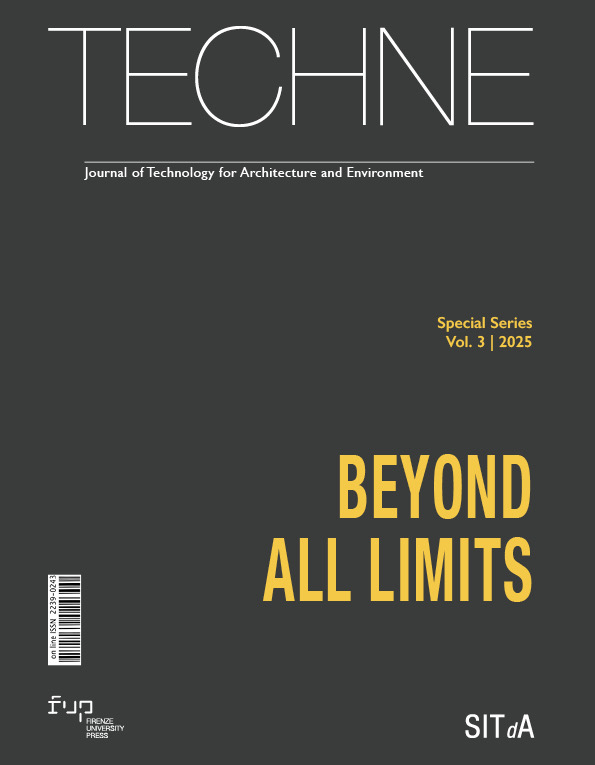Published 2025-07-31
Keywords
- planning,
- architecture,
- design,
- New European Bauhaus
How to Cite
Copyright (c) 2025 Tiziana Ferrante

This work is licensed under a Creative Commons Attribution 4.0 International License.
Abstract
The content of this Special Issue draws upon the scientific debate initiated during the “Beyond all Limits: International Conference on Sustainability in Architecture, Planning, and Design”, held in May 2022 at Vanvitelli University, Naples. The discussion focused on the latest international approaches to sustainability, as applied to the fields of planning, architecture, and design, and interpreted through the principles of the New European Bauhaus (NEB).
Hence, focusing on novel design, operational and cultural strategies, aligned with the three pillars of the New European Bauhaus (NEB)-Sustainability, namely Aesthetics, Inclusion and a human-centred vision, can provide insights into rethinking the very meaning of sustainability, which is increasingly invoked while being at risk of becoming a mere slogan or rhetorical device. In the current context, the ecological transition and its social and cultural implications need to bridge the widening gap between institutional declarations and the everyday practices of citizens. This requires moving beyond a purely technical view of sustainability that lacks its ethical and social dimensions. The trajectory initiated with the “Beyond all Limits” Conference and continued in this Special Issue of TECHNE aims to investigate underexplored themes of sustainability, viewed as a cultural, social, and political act capable of renewing-through the experimental dimension of design disciplines-not only the forms of the built environment but also the deeper meaning of our contemporary living.
Downloads
References
- Bonino, M. and Mancini, M. (2021), “Reconnecting Human Body and Urban Space: Reading Tools and Design Practices”, World Architecture, vol. 369, pp. 78-85.
- European Commission (2021), New European Bauhaus: Shaping a greener and fairer way of life, Publications Office of the European Union.
- Ferrante, T. and Romagnoli, F. (2023), “Support or automation in decision-making: the role of artificial intelligence for the project”, Techne, Vol. 25, pp. 68-77, available at: 10.36253/techne-13713 DOI: https://doi.org/10.36253/techne-13713
- Ferrante, T., Romagnoli, F. and Villani, T. (2023), “Sustainable Urban Development. Organizing information content for the transition to Positive Energy Districts”, AGATHÓN International Journal of Architecture, Art and Design, n. 13, pp. 191-204, available at: https://doi.org/10.19229/2464-9309/13162023.
- Figueiredo, Y. D. S., Prim, M. A. and Dandolini, G. A. (2022), “Urban regeneration in the light of social innovation: A systematic integrative literature review”, Land Use Policy, Vol. 113, available at: https://doi.org/10.1016/j.landusepol.2021.105873. DOI: https://doi.org/10.1016/j.landusepol.2021.105873
- Gehl, J. (2011), Life between Buildings: Using Public Space, Island Press, Washington DC.
- Harvey, D. (2013), Rebel Cities: From the Right to the City to the Urban Revolution, Verso Books, New York, NY.
- Manzini, E. (2015), Design, When Everybody Designs: An Introduction to Design for Social Innovation, MIT Press, Cambridge, MA. DOI: https://doi.org/10.7551/mitpress/9873.001.0001
- Pratt, B. (2023), “Equitable Urban Planning for Climate Change”, Journal of Planning Literature, Vol. 38, n.1, pp. 59-69, available at: https://doi.org/10.1177/08854122221138125. DOI: https://doi.org/10.1177/08854122221138125
- Raworth, K. (2017), Doughnut Economics: Seven Ways to Think Like a 21st-Century Economist, Random House, London.






